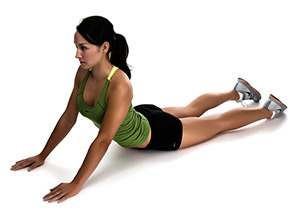
Learn about exercises that can relieve simple cases of pain.
Once you encounter back or neck pain, you are four times as likely to experience it again. This is why prevention is essential to your long-term recovery.
One of the best ways to avoid back pain is by exercising and stretching. Low-impact aerobics, such as walking or swimming, is an ideal way to prevent or treat back pain. Stop if the exercise becomes painful, and always remember to stretch. Stretching is easy to incorporate into your daily routine. You can even do it in front of the television.
Below are some more specific ways to prevent back or neck injuries:
The spine likes movement. Anything that puts the spine
in a static position creates stress, which can cause back and neck pain.
Every hour, stand, walk around, bend, arch backward gently, and twist.
Doing so at regular intervals will lengthen the amount of time you can
sit comfortably. Also, get an ergonomically-designed chair or an orthopedic
insert to support your spine, espe cially if your job involves long periods
of sitting. Or roll up a towel, and place it behind your low back.
cially if your job involves long periods
of sitting. Or roll up a towel, and place it behind your low back.
Prolonged standing can also strain the back. If you have to stand for long periods of time, prop one foot on a small stool or telephone book to reduce stress in the low back. Alternate with the other foot. Every half hour, bend over and touch your toes, with your knees slightly bent, or do some of the stretching exercises shown in the Texas Spine and Scoliosis website. They will help loosen your muscles, ligaments and joints.
While traveling on a plane, it helps to raise your feet on a briefcase or a bag underneath the seat in front of you. Ask for a pillow to place behind your low back to improve lumbar support. It is important to get up frequently and walk to the bathroom and back, whenever possible. Avoid hour-long periods in your seat.
Avoid sleeping on your stomach, which arches your back and puts pressure on your spine. Instead, lie on your back with a small pillow tucked under your knees. This position unloads the spine. An alternate position is to lie on your side with a pillow between your knees. If you like sleeping on your stomach, place a soft, flat pillow under your stomach to eliminate some of the arch that can stress your back.

Mattress considerations
It is important to sleep on a mattress with optimal back support, whether it is a conventional mattress or a waterbed. Older waterbeds were mushy and provided little support. However, now there are waterbeds that allow you to adjust their firmness. A good mattress should relate to your body shape. Generally, go with what feels comfortable to you.
Pain is a signal from the body to the brain that something is wrong. Either the back is too weak, too inflexible, or the wrong body mechanics were used to perform a task.
Texas Spine and Scoliosis is a specialty center of Seton Family of Hospitals. Click here to visit the GoodHealth website for fitness and nutrition information provided by Seton Family of Hospitals.